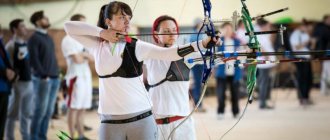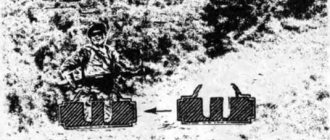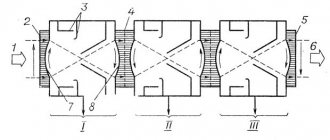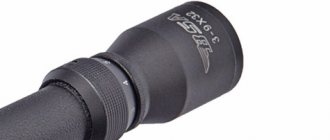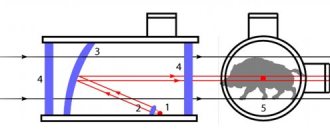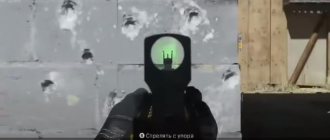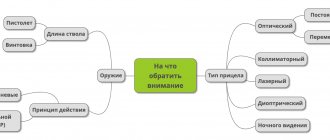IN
In this article we will look at:
- Operating principle of night vision sights
- Selecting a digital sight or night vision
- Selecting a night vision scope from the image
- How does “fear” of light influence your choice?
- Choosing a night vision scope depending on cost
- Impact resistance of night vision scopes
- Selection of reticles
- The influence of custom functions on the choice of night vision scope
- Choosing a night sight for hunting
- Choosing a night vision scope based on price/quality
Hunting at night differs from standard daytime shooting in that it requires more experience and the presence of specialized devices. Animals that live after sunset are better able to navigate the terrain in the dark, which is of interest to hunters. At night, without devices, it is difficult to assess the terrain or track an animal. Night vision devices come to the rescue.
Operating principle of night vision sights
Everything we see appears to be the reflection of solar or artificial rays from objects. At night there is no sun, but this does not mean that there is no reflection. In most cases, the moon, stars, and reflected light from clouds help to see objects. In the absence of such, auxiliary illuminators are used. Visible light sources, for example, under-barrel lights, simplify the search, but do not provide camouflage to the hunter. Night vision scopes can pick up even faint reflections and amplify them. The work is based on sensitive converters that convert photons into an electronic or digital signal. Night vision scopes are divided into two types of transducer:
| Sights based on an electron-optical converter (EOC) | Digital sights based on a sensitive sensor |
| The converged beam of photons knocks out electrons from the cathode. Electrons are accelerated by applying voltage to them and are recorded on the screen with a green glow. The greater the momentum of the photon, the stronger the electron accelerates and the brighter the glow. | The converged beam of photons hits a photocell, from which intensity values are collected. Electronic processing increases the brightness parameters, and the picture is displayed on the display. |
Comparison table of the presented models
Brief characteristics of the devices discussed above are listed below.
| Model | Magnification, ratio | Optics, mm | Warranty, years | Weight, kg | Dimensions, cm |
| Bering Optics Wake2 2.5×40 G1 | 2.5 | 40 | 2 | 0.43 | 22.3x11.0x7.0 |
| NVMT Yukon Spartan 1x24 | 1 | 24 | 1 | 1.17 | 29.5x24.5x12.5 |
| Bresser National Geographic 3×25 | 3 | 25 | 5 | 0.39 | 17.5x7.0x10.0 |
| Yukon Tracke Googles 1x24 | 1 | 24 | 3 | 1.1 | 10.0x30.0x18.0 |
| Dipole 212 SL 3.5x Laser | 3.5 | 45 | 1 | 1.2 | 20.0x13.0x7.0 |
| Bresser NightSpy 5×50 | 5 | 50 | 2 | 1.68 | 21.5x19.0x9.5 |
| Dipole 128, 2+ | 10 | 55 | 3 | 0.61 | 13.0x7.0x6.0 |
Selecting a digital sight or night vision
The two listed types of converter have significant differences for selection; the main ones are presented in the table:
| Distinctive features | ||
| Device type | Night sight | Digital sight |
| Image | In shades of green / black and white | Black and white |
| Anti-glare | Only for devices of 2+,3 generations | All devices |
| Comparative Cost | From budget 1st generation to expensive 3rd generation | Middle price segment |
| Impact resistance to large calibers | Certain brands and scopes 2nd and 3rd generation | All models |
| Reticles | One at a glance | Various options |
| Functionality | Simplified | Extended |
Let's consider how the features listed above influence the choice:
Selecting a night vision scope from the image
During the day, due to the infrared spectrum of sunlight, a person is able to distinguish colors, but at night everything comes down to a monochrome image. The green color in devices with an image intensifier tube is explained by the glow of the phosphor when electrons hit it, the black and white color in digital sights is due to the use of an appropriate display. There are technologies for applying phosphorus to create black-and-white electron-optical converters. According to reviews from hunters, the ease of use of one and the other type of display is comparable:
- “The green glow makes the eyes less tired in the dark, which is more convenient for long-term observations”
- “With black and white light, the image looks contrasty, so it’s more effective when searching for a target.”
The human eye can distinguish about 400 shades of green, so the observer can better recognize the surrounding area, and with a black and white image, the contrast between the target and the background increases. Therefore, the hunter himself decides which image suits him. The color of the glow does not affect the recognition range, but the corresponding colors complement the image in winter and summer:
| Green glow, summer forest | Black and white image, winter forest. |
- The choice of a night sight based on the “image color” parameter depends on personal preferences.
- Sights with a black and white image intensifier are more expensive than those with a green image intensifier.
How does the “fear” of illumination influence the choice?
One of the main problems in the budget segment of night vision devices is the possibility of illuminating the image intensifier tube. This problem occurs with devices with 1st generation image intensifier tubes. In fairly bright lighting, for example in the daytime, the amount of light is in excess, and the devices, according to a given algorithm, increase the speed of electrons, which leads to oversaturation and failure of the phosphor. Limiting the luminous flux is set in expensive models of the 2nd and 3rd generation, but observation during the day with the lid open (without a filter) is prohibited. Digital sights do not have restrictions on the light output, since the load is taken on by the sensor, and therefore belong to the “day-night” class.
- When choosing night sights, you need to remember the requirement to close the filter cover in bright light.
- Digital sights work at any time of the day, this is effective in the pre-dawn and twilight hours.
Choosing a night vision scope depending on cost
In the price category, it is immediately worth noting the difference in cost of the first, second and third generations. Differences in image intensifier tubes are related to internal components and sensitivity, which leads to differences in viewing distances. The first generation is suitable for shooting at short distances up to 100 meters, is often used by beginners and is cheaper than all those presented. The second and third generations detect targets at distances of up to 300 and 500 meters, respectively, with an approximate cost in the range of 100 – 300 thousand rubles. Digital sights, with a viewing range of up to 300 meters and a price ranging from 30 to 90 thousand rubles, occupy a place between the first and second generations.
- Think about the shooting range of your caliber and your experience of hunting at night, based on this, it is easier to choose a night sight based on price.
- Budget digital sights – Yukon Sightline N455 series.
Impact resistance of night vision scopes
The concept of impact resistance is directly related to the display of the reticle. In sights with image intensifier tubes, as in optical sights, the aiming reticle is located on a separate lens with a spring fixation using an engraving method. The worm fastening mechanism ensures the movement of the lens in two directions - horizontal and vertical. When fired, the load from recoil is transferred to the springs supporting the lens to return to its original state. Each scope is characterized by a certain durability. Most first-generation devices are suitable for guns with muzzle energy up to 3700 J. The special case of installing “night lights” on smooth-bore weapons involves the use of more stable sights that can withstand over 4200 J (.12 caliber). Such sights include the Dedal-180HR. 2nd and 3rd generation devices are designed with powerful output in mind. The aiming mark in digital devices is displayed on the display. They do not have lenses with a spring system, which means that the impact of recoil does not play any role for them, provided that all internal elements are firmly fixed in the body.
- Before you buy a night sight, check to see if it can handle your caliber.
- Digital and 2nd and 3rd generation sights are suitable for all guns.
Selection of reticles
From the previous paragraph you can understand that in a sight with an image intensifier tube, only one reticle option is possible. Electronic components of digital devices and display output allow you to change the types of reticles depending on the firing range, size and behavior of the animal. It is worth noting that zeroing in digital sights is carried out using the coordinate method, which is used to remember the zeroing positions of several guns. At night, the distances are small, so a common grid option is a “cross” or “half-cross”. If shooting at a distance at which the bullet drop is noticeable, then reticles with correction strokes are selected.
- When choosing a sight with an image intensifier, check the type of reticle.
- Many manufacturers produce several versions of the same scope with different reticles.
The influence of custom functions on the choice of night vision scope
The software of digital sights increases the number of functions compared to sights with analog sights with image intensifier tubes. For example, the Digisight series digital sights have one-shot zeroing capabilities, video recording, and connectivity to mobile devices. The only thing that can contrast sights with image intensifiers is the change in color and the degree of brightness of the aiming mark.
- If there is a need to use video recording devices, then choose digital sights
- Analogue devices are easier to use due to the small number of functions.
Choosing a night sight for hunting
It is worth noting that the distances at which shooting is usually carried out during the day must be reduced at night in order to be more confident in accuracy. Walking in the dark over rough terrain in search of a wounded animal is a difficult task. At night, they often hunt from towers and storage sheds with a long wait for the animal to come out. Depending on the behavior and habitat of the animal, the type of terrain is divided into two main ones - forest and open field. Since night vision scopes require lighting, branches and tree foliage interfere with viewing as they block the light from the moon or stars. Hunting in the forest requires additional illuminators or more sensitive sights. In open areas under the same conditions, the image brightness is higher. Trees in the forest limit the observation area, so a magnification of night sights in the range of 2 to 4 times is considered sufficient. For aiming in open areas, it is more convenient to use sights with high magnification. This is achieved by lenses with a larger diameter or digital zoom. The larger the lens, the more light passes through it, which means the image will be brighter, but the scope will be heavier. In addition to the lens, the recognition range depends on the generation of the image intensifier. Digital sights have high magnification indicators, and 3rd generation sights have high range indicators.
- When choosing a night sight for hunting, check the magnification depending on the expected distances.
- The further the shooting distance, the greater the magnification, lens or sensitivity (ICT generation) should be.
Choosing a night vision scope based on price/quality
As a result, the hunter approaches the issue of choosing a night vision scope based on the criteria of price and quality. For most tower shooting situations, first generation scopes are chosen due to their suitable shooting distances. For calibers up to .308 (up to 3700 J), the series of Belarusian Sentinel sights is suitable, which is profitable to buy due to the integrated bracket. For powerful calibers up to 6000 J, for example .12, buy a Dedal-180HR or a Yukon Sightline digital sight. For open areas within 200 -250 meters, the first generation will not be enough, and hunters buy digital sights or the 2nd generation. A modern and practical “digital camera” – Digisight Ultra. The second generation is represented by the Pulsar Phantom series with different types of lenses and magnification. The third generation is less often used in hunting due to cost. More often, the use of such sights is associated with special services and security organizations. But if you want to buy a night vision scope for hunting with a 3rd generation image intensifier tube, then the best choice is the Dedal-NV series.
Kinds
According to the form factor of the device, the following positions are distinguished:
- Monocular. Mini spyglass. The most affordable option in terms of price/quality ratio. It weighs little and takes up minimal space.
- Binoculars. There are civilian and military purposes. They differ from the previous type by the possibility of binocular (stereo) vision, which increases a person’s viewing angle when working in low light conditions. Typically, the optical system in binoculars has multiple zoom and provides better visibility compared to a monocular.
- Glasses. They are equipped with one converter and one lens, but thanks to parallelization of the signal, a pseudo-stereo image is achieved (the same picture is displayed on both eyes). They are attached with straps to the head and cannot be approached.
- Sights. Structurally they resemble a monocular, but additionally have an aiming reticle, an exposure meter, a system for estimating the distance to an object (optional) and a shank of a certain standard to mount the device on a small weapon.
Display Specifications
Many factors influence the choice of monitor, but by and large it is a matter of taste: the shooter himself determines which visualization to give preference to. Digital models show a clear advantage when comparing images obtained under the same lighting and other conditions. In addition, these modern sights with high-definition displays often cost significantly less than competing image intensifier tubes.
Here are the parameters you should pay attention to:
- presence of zoom;
- maximum resolution;
- clarity of display of near and distant objects;
- field of view angle (multiplicity);
- frame-in-frame mode (an additional image located on top of the sight);
- brightness and contrast settings;
- availability of choice of color schemes;
- speed – how quickly the matrix captures objects;
- power and type of backlight.
Pulsar Digisight N770A
Pulsar digital sights are also produced. Digisight N770A is a device in the mid-price category. Can be used both day and night. Created on the basis of a CCD matrix, it provides effective shooting at a distance of up to 450 meters. The sight can be used with large-caliber weapons, the maximum permissible muzzle energy is 6000 J. Thus, the Digisight N770A can be installed on both rifled and smooth-bore weapons. The optical zoom is 4.5x, and the digital zoom is 1.5x. There is a built-in infrared laser illuminator with three power levels. Its light cannot be seen with the naked eye.
Pulsar Digisight N770A sights are equipped with a fifty-millimeter lens. The exit pupil is 67 mm away, which puts this scope among the best among devices in its class. The OLED display installed in the device is frost-resistant, has a resolution of 640 x 480 pixels and provides a clear image even at low temperatures. Image quality is also ensured by the SumLight and Contrast quick adjustment functions.
External influences
"Number"
It does not have spring mechanisms, as in analog sights, so recoil does not affect performance. The first devices were afraid of low temperatures, since they were equipped with LCD displays: in the cold they began to slow down and froze.
In 2022, all sights are equipped with special monitors that can withstand temperature fluctuations from -25 to +40ºС. Basically, it all depends on the type, build quality and buyer choice.
In swamps or coastal areas, you should worry about moisture resistance. The device must also withstand high loads - shocks, falls, pressure changes. The stronger the shell and the more securely the elements are secured inside the box, the better the scope.
Additional options
Various additional options allow you to improve shooting accuracy. Depending on the manufacturer, sights are equipped with special programs, electronics or special modes.
Additional sight options:
● Wi-Fi – broadcast photos or videos directly via a mobile phone or the Internet.
● GPS navigator, compass, etc.
● Reinforced housing – protects against impact, wear and moisture.
● Availability of remote control.
● Possibility of video and photography.
● Replaceable lenses. Included in the kit or ordered separately.
Similar functions are found in both expensive and budget night sights. However, inexpensive devices are easier to maintain. Therefore, beginners should not focus on the multitasking of the sight: we advise you to choose 2-3 additional options.
The best among budget devices
Popular devices include the Yukon Sightline N455 and N475
. These are universal sights that are used for hunting. The N455 / N475 digital sights have their advantages:
- HD Amoled touch display (1024×768);
- magnification 4-16x/6-24x;
- sight range – 350 m/400 m;
- increased sensitivity;
- different changeable grids;
- zeroing with one cartridge (Zoom Zeroing);
- 3 shooting profiles;
- instant on;
- quick charger battery;
- one-button sight control;
- built-in IR illuminator;
- picture-in-picture mode.
Advantages
You can buy a digital analogue of the 2nd generation for an amount of 40 thousand rubles, which is an order of magnitude lower than that of devices with a converter. Another advantage is the quality of the output image; it is at a high level both in the center and on the sides, but in digital format there is also a drawback: the image may “slow down” slightly. Thus, it can become a problem when using a digital sight to shoot at a moving animal or to shoot from an approach, but if you can let it “tune in” and hold the target at the front sight, then it will be in no way inferior to a device with a converter.

